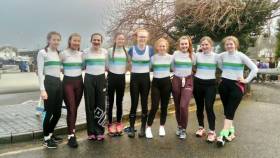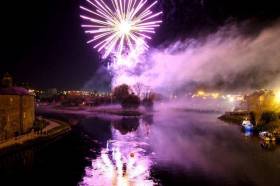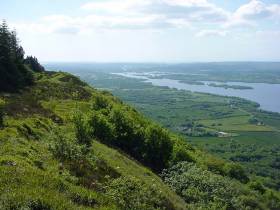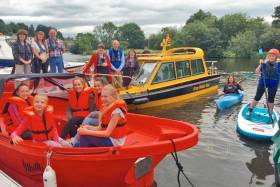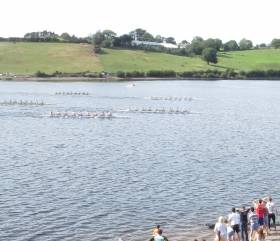Displaying items by tag: Enniskillen
Enniskillen and Coláiste Iognáid Pick up Pennants at Carrick
#Rowing: The Head of the Shannon enjoyed good weather and an appreciative crowd at Carrick-on-Shannon on Saturday. The timing system encountered some difficulties. Neptune’s junior 18 quadruple were the fastest crew in the first head. The pennant for this class was granted in the second head and Enniskillen took it. The Fermanagh club had a set of wins at junior level, as did Coláiste Iognáid of Galway. Commercial’s junior 16 women’s eight also came out on top.
Head of the Shannon, Carrick-on-Shannon, Selected Results (Category winners)
Head One
Men
Eight – Jun 16: Col Iognáid. Masters: Neptune (d)
Four – Jun 18, coxed: Enniskillen
Pair – Sen: Galway. Jun 18: Enniskillen
Sculling
Quadruple – Jun 16, coxed: Sligo. Masters: Galway (e). Masters, coxed: Athlone (e).
Double – Sen: Portadown. Masters: City of Derry (d). Jun 18: Enniskillen
Single – Jun 16: Athlone (Carroll)
Women
Eight – Jun 18: Col Iognáid
Four – Club, coxed: Athlone
Sculling, Quadruple – Jun 18: Enniskillen
Double – Club: Carrick-on-Shannon. Jun 16: Commercial
Single – Club: Carrick-on-Shannon (Early). Jun 18: Enniskillen (Fee)
Head Two
Men
Eight, Jun 18: Portadown
Four – Masters, coxed: Athlone (b)
Sculling
Quadruple – Jun 18: Enniskillen
Double – Club: Enniskillen. Jun 16: Enniskillen
Single – Sen: Sligo (G Patterson). Jun 18: Carrick-on-Shannon (Early). Masters: Athlone (Gallen, f)
Women,
Eight
Club: Galway. Jun 16: Commercial. Masters: Tribesmen B (e)
Four – Jun 18: Col Iognáid.
Pair – Jun 18: Col Iognáid
Sculling
Quadruple – Jun 16, coxed: Sligo.
Double – Jun 18: Enniskillen
Single – Club: Carrick-on-Shannon (T Duggan). Jun 16: Carrick-on-Shannon (Murtagh).
Fireworks & Flotilla In Enniskillen For Hallowe’en Night
#InlandWaters - Waterways Ireland advises all masters and users of the Erne Navigation that a fireworks display will take place at Castle Island in Enniskillen on Hallowe’en night (Tuesday 31 October) from 8pm to 8.30pm.
Boat masters should also be aware of an event called Light Up the Lough which will take place prior to the fireworks display from 6.30pm.
Light Up the Lough is a flotilla of lit-up vessels from Erne Paddlers, Row the Erne and Erne Boat Hire Ltd. The boats will be dressed in lights and will circle around Castle Island four an hour.
Passing vessels must keep wash to a minimum and stay clear of this activity.
Masters of vessels are advised that there will be no mooring permitted at Waterways Ireland Head Office moorings nor at the Henry Street Public Jetties on the day of the event in the interest of public safety.
Navigation in the vicinity of Castle Island is also prohibited for the duration of the event.
Alternative moorings are available at the Forum and Regal Pass jetties with easy access to event vantage points.
Instructions from safety vessels must be adhered to at all times.
Further information may be had from the Lough Erne Manager/Warden at Waterways Ireland Head Office at 0044 48 66322836.
Waterways Ireland Archive Open To Visitors This Weekend
#InlandWaters - The Waterways Ireland Archive in Enniskillen is open for tours today and tomorrow (Saturday 9 and Sunday 10 September) as part of the European Heritage Open Days taking place across Northern Ireland this weekend.
From 1pm to 5pm today and tomorrow, visitors can dive into the archives to discover the history of the inland waterways, and explore original archive material.
You'll also get a free tour of the building (tours start at 1pm, 2pm, 3pm and 4pm) which will include the chance to see the solo exhibition ‘Elsewhere’ by artist Douglas Hutton, showcased as part of the Fermanagh Live arts festival.
The exhibition will remain open to the public from 7pm in the evening throughout the festival until Saturday 30 September.
Woman Dead After Fall From Boat On Lower Lough Erne In Bank Holiday Weekend Tragedy
#Enniskillen - The Sunday Life reports that a woman has died after falling from a boat in Enniskillen in the early hours of yesterday morning (Saturday 26 August).
The PSNI recovered the woman and a man from the waters of Lower Lough Erne after reports that they had fallen in near their boat mooring at the Round O jetty.
Both were transferred to South West Acute Hospital for treatment but the woman, aged 49, was pronounced dead shortly after. A post-mortem is expected.
The Sunday Life has more on the story HERE.
Enniskillen Blueway Activity Hub Now Open For Business
#InlandWaters - The newly opened Enniskillen Blueway Activity Hub offers a range of activities from guided canoeing and kayaking tours to electric bike hire, day boat hire and water taxi tours.
Developed by Waterways Ireland with the Enniskillen Business District and based at its offices on Sligo Road along the River Erne, the new hub makes Fermanagh’s county town the perfect base to explore Lough Erne and the wider Lakelands region.
Full details, maps and pricing are available at www.bluewaysireland.org
#Rowing: Ireland picked up more wins at the Home International Regatta in Strathclyde today. Early in the day they had won the women’s and men’s lightweight pairs. The women’s senior double of Chloe Mehigan (Cork) and Claire Feerick (Neptune) won a good battle with Scotland to take the senior women’s double, and Ireland’s junior four of Mia Jane Elliot, Zoe McCutcheon, Caitlyn Fee and Miriam Kelly also won. They are all Enniskillen rowers.
Home International Regatta, Strathclyde (Ireland Winners; early)
Men
Lightweight Pair: C Hennessy, S O’Sullivan
Women
Double: C Mehigan, C Feerick
Lightweight Pair: G Crowe, H O’Neill
Junior – Four: MJ Elliot, Z McCutcheon, C Fee, M Kelly
#Rowing: The big crowds saw a close and exciting senior men’s eight final at the Irish Rowing Championships. Commercial carved out a small lead early on, and despite pressure from NUIG and Skibbereen, they held on to win.
In the women’s senior eights final, UCD/Old Collegians had to wait until the middle stages to take over in the lead, but once they did they built and built on it. They had over three seconds at the finish over Skibbereen/UCC.
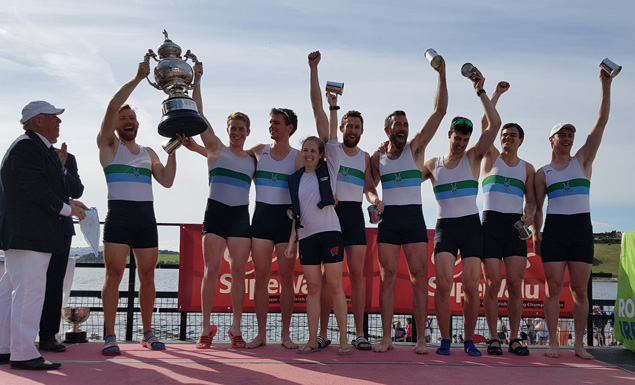 Winners of senior men’s eights (Commercial)
Winners of senior men’s eights (Commercial)
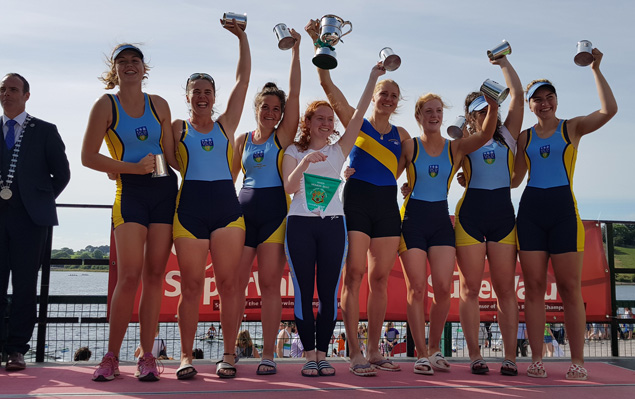 Winners of senior women’s eights (UCD/Old Collegians – Claire Lambe not included)
Winners of senior women’s eights (UCD/Old Collegians – Claire Lambe not included)
NUIG took their ninth title as they lifted the women’s club eight, while Enniskillen brought a very successful end to a good regatta for them by taking the men’s junior pair through Aaron Johnston and Nathan Timoney.
Three Castles also had a fruitful Championships and their junior quadruple won.
Lee and Clonmel won the women’s junior quad and the men’s intermediate double respectively and Bann’s Hannah Scott took the women’s intermediate single sculls title.
Irish Rowing Championships, National Rowing Centre, Day Three (Selected Results)
Men
Eight – Senior: 1 Commercial 5:46.04, 2 Skibbereen 5:47.95, 3 NUIG 5:48.39. Novice: Queen’s 6:21.56.
Four – Club, coxed: NUIG A 6:43.38.
Pair – Inter: NUIG 6:56.09. Junior: Enniskillen B 6:52.04.
Sculling, Quadruple – Junior: 1 Three Castles 6:21.53, 2 Shandon 6:22.75, 3 Clonmel 6:23.05.
Double – Inter: Clonmel 6:37.17. Junior: Three Castles A 6:50.22.
Single – Lightweight: Skibbereen (G O’Donovan) 7:22.32. Inter: Clonmel (D Lynch) 7:10.25.
Women
Eight – Senior: 1 UCD/Old Collegians 6:24.84, 2 Skibbereen/UCC 6:27.96, 3 NUIG/Cork 6:33.67. Club: NUIG 6:46.97.
Four – Inter, coxed: NUIG 7:23.65.
Pair – Senior: UCD (A Crowley, E Lambe) 7:37.41. Junior: Fermoy 7:53.37.
Sculling, Quadruple – Junior: Lee 6:54.96.
Single – Senior: Old Collegians (S Pupsure) 8:02.64. Lightweight: Skibbereen (D Walsh) 8:09.96. Inter: Bann (H Scott) 7:55.58. Club One: Carlow (C Nolan) 8:15.22.
#Rowing: Skibbereen took two titles and NUIG took three from the second set of finals on the third day of the Irish Rowing Championships at the National Rowing Centre.
Gary O’Donovan and Denise Walsh had very easy wins in the bright sunshine in the finals of the lightweight single sculls. NUIG’s victories – which bring them to eight so far – came in the men’s intermediate pair, where they were tested by Shandon; the women’s intermediate coxed four and the men’s club coxed four.
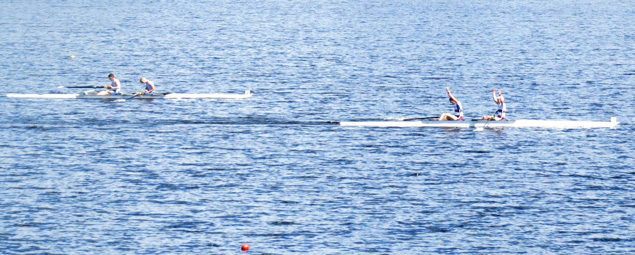 NUIG celebrate after beating Shandon in the intermediate men's pair
NUIG celebrate after beating Shandon in the intermediate men's pair
Eliza O’Reilly and Gill McGirr have been the best junior pair in the country this year and the Fermoy crew proved it with their convincing win. Daire Lynch was similarly emphatic as he took the intermediate single sculls title for Clonmel.
 Fermoy on their way to winning the women's junior pair
Fermoy on their way to winning the women's junior pair
Rory Quinn and Oisin Clune of Three Castles added another win to the one they had earlier taken in the junior quadruple when they won the junior double.
Irish Rowing Championships, National Rowing Centre, Day Three (Selected Results)
Men
Eight – Novice: Queen’s 6:21.56.
Four – Club, coxed: NUIG A 6:43.38.
Pair – Inter: NUIG 6:56.09
Sculling, Quadruple – Junior: 1 Three Castles 6:21.53, 2 Shandon 6:22.75, 3 Clonmel 6:23.05.
Double – Junior: Three Castles A 6:50.22.
Single – Lightweight: Skibbereen (G O’Donovan) 7:22.32. Inter: Clonmel (D Lynch) 7:10.25.
Women
Four – Inter, coxed: NUIG 7:23.65.
Pair – Senior: UCD (A Crowley, E Lambe) 7:37.41. Junior: Fermoy 7:53.37.
Sculling, Single – Senior: Old Collegians (S Pupsure) 8:02.64. Lightweight: Skibbereen (D Walsh) 8:09.96. Club One: Carlow (C Nolan) 8:15.22.
Big Win for UCD's Crowley and Lambe At Rowing Championships
#Rowing: UCD’s Eimear Lambe and Aileen Crowley had an impressive win in the women’s senior pair in the deferred finals at the start of the third day of the Irish Championships at the National Rowing Centre. Skibbereen and Cork were in the touch with the UCD women until 1500 metres, but Lambe and Crowley left the rest behind from there and won by 10 seconds from Skibbereen.
Queen’s were also impressive in their win in the men’s novice eight, and Sanita Puspure won the senior single sculls with plenty to spare.
The junior 16 men’s eight went to Enniskillen, who thus completed the set of wins: the junior 18 and 16 eights for men and women.
Irish Rowing Championships, National Rowing Centre, Day Three (Selected Results)
Men
Eight – Novice: Queen’s 6:21.56.
Sculling, Quadruple – Junior: 1 Three Castles 6:21.53, 2 Shandon 6:22.75, 3 Clonmel 6:23.05.
Women
Pair – Senior: UCD (A Crowley, E Lambe) 7:37.41.
Sculling, Single – Senior: Old Collegians (S Pupsure) 8:02.64.
Early Movers Take Spoils at Irish Rowing Championships
#Rowing: On a morning of clear victories, David Higgins of Presentation Boat Club, Cork, had to battle to see off Luke Hayes-Nally of Shandon to take the Club Singles title at the National Rowing Centre.
The other wins in the Saturday morning session of the Irish Rowing Championships followed the pattern of one crew gaining an early lead and winning well. Mark O’Donovan and Shane O’Driscoll in the pair; NUIG in the women’s novice eight; Enniskillen in the men’s junior coxed four and Cork Boat Club’s Lisa Dilleen and Chloe Mehigan in the women’s intermediate double all came home well clear of the field.
Hannah Scott made her move so early that she had three-quarters of the junior single sculls final as clear leader. Margaret Cremen held off Aoife Casey for second.
The men’s intermediate eight final was a UCD affair – their A crew beat their B crew in a tight finish.
Irish Rowing Championships, Day Two (Selected Results)
Men
Eight – Intermediate: UCD 5:50.02.
Four – Junior, coxed: Enniskillen 6:22.94.
Pair – Senior: Skibbereen 6:59.69.
Sculling, Single – Club: Cork (D Higgins) 7:26.59.
Women
Eight – Novice: NUIG 6:38.95.
Sculling, Double – Intermediate: Cork 7:09.95.
Single – Junior: Bann (H Scott) 7:41.22.



























